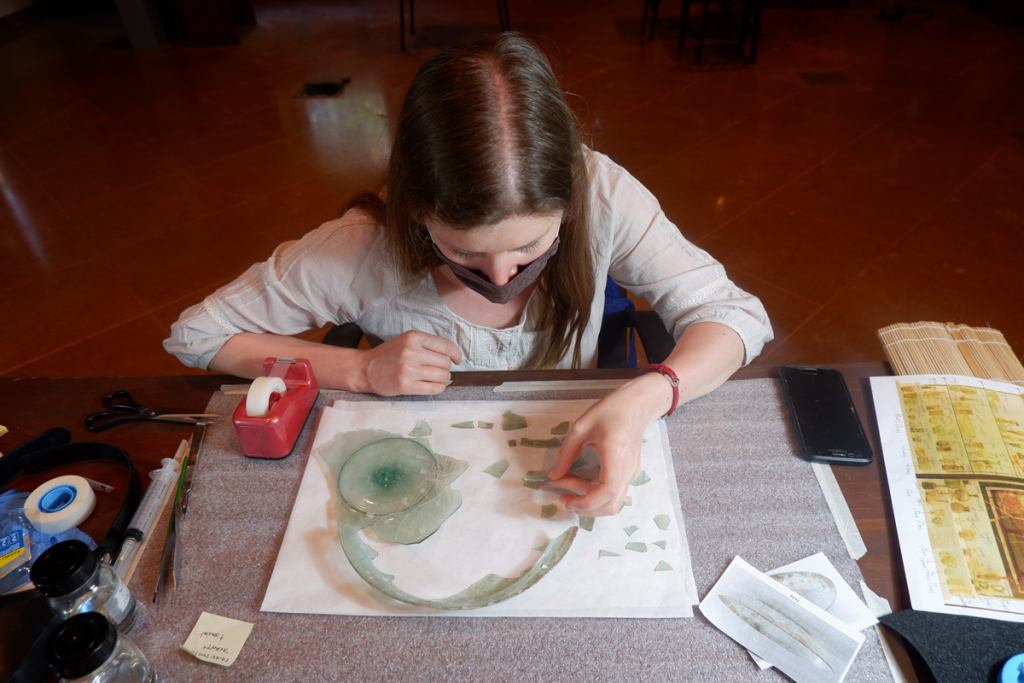 Conservator Claire Cuyaubère assisting with “puzzle-work” of shard from a glass dish at the Archaeological Museum, AUB. Courtesy AUB Office of Communications and Archaeological Museum
Conservator Claire Cuyaubère assisting with “puzzle-work” of shard from a glass dish at the Archaeological Museum, AUB. Courtesy AUB Office of Communications and Archaeological Museum
Almost a year after a devastating explosion shook Lebanon’s capital, the British Museum and The European Fine Art Foundation (TEFAF) will partner to help restore ancient artifacts that were damaged by the blast. The museum and the fair will restore eight glass vessels dating to Roman and early Islamic times.
The works were on view at the Archaeological Museum at the American University of Beirut, two miles away from the explosion that rocked the city last August. During the blast, the glass objects shattered into hundreds of shards. They will now be pieced together at the British Museum’s conservation labs in London. Before returning to Beirut, the restored glass works will go on view at the British Museum in a temporary exhibition.
In a statement, Sandra Smith, head of collection care at the British Museum, said, “Glass is a very difficult material to reconstruct, not least because the sherds flex and ‘spring’ out of shape and have to be drawn back under tension to restore the original shape. Doing this for hundreds of pieces is a delicate process but our world class facilities and highly experienced conservation staff will ensure these items are preserved to exceptional standards.”
The eight works that are set to be restored were on view in a glass case with 64 other glass objects, the majority of which were deemed damaged beyond on repair. (Seven other glass objects are considered repairable, but are too fragile to travel to London.) Nadine Panayot, a curator at the AUB Archaeological Museum, described the destruction of many of these objects as “a priceless cultural loss for Lebanon and the Near East.”
The glass vessels are significant because they offer insights into how glass was blown during the 1st century B.C.E., when ancient Lebanon (then known as Canaan) was considered glassmaking center of the world. Six of the objects date to when glass was first mass produced, while the other two come from a few centuries later, during the late Byzantine and early Islamic periods. These latter two works may have been imported to Lebanon from Syria or Egypt.
Jamie Fraser, a British Museum curator who is an expert on the region’s ancient civilizations, said in a statement, “The glass vessels have survived several disasters and conflicts over the last 2,000 years, only to be shattered by the port explosion in 2020. Their restoration reflects the resilience of the staff at the Archaeological Museum, and the importance that Lebanon places on its rich cultural heritage.”
TEFAF is primarily known for its art fairs in the Netherlands and New York. The fair will support the British Museum’s conservation efforts for the glass vessels through its Museum Restoration Fund, which was established in 2012 to aid museums in restoration and research of important artifacts. TEFAF chairman Hidde van Seggelen said in a statement, “Their return to their rightful form is a powerful symbol of healing and resilience after disaster.”
Source link : https://www.artnews.com/art-news/news/british-museum-tefaf-glass-restoration-beirut-explosion-1234600012












